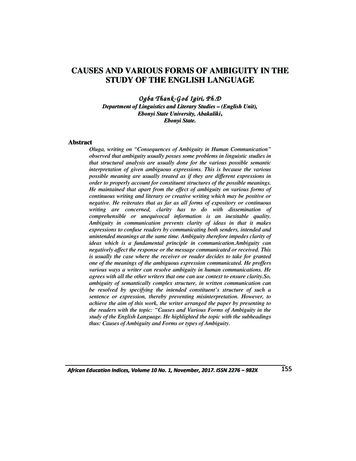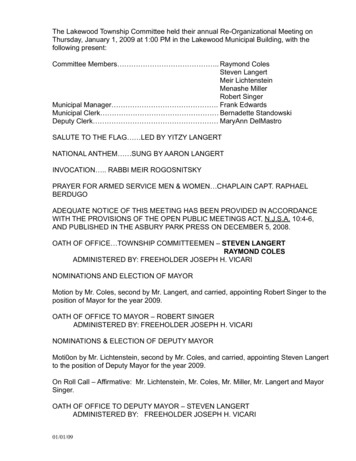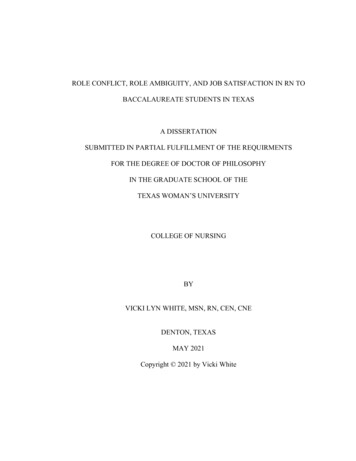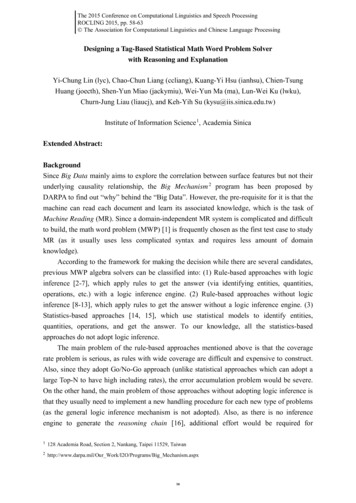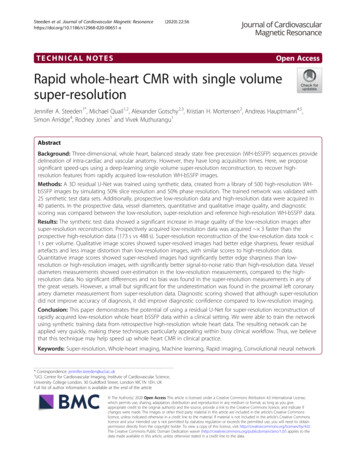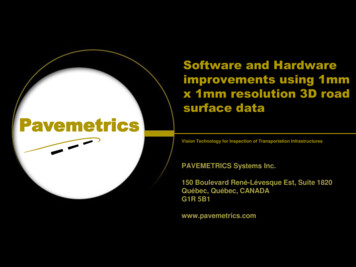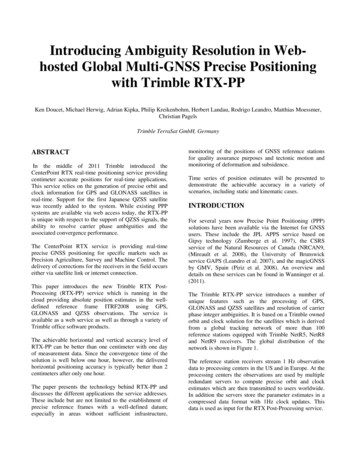
Transcription
Introducing Ambiguity Resolution in Webhosted Global Multi-GNSS Precise Positioningwith Trimble RTX-PPKen Doucet, Michael Herwig, Adrian Kipka, Philip Kreikenbohm, Herbert Landau, Rodrigo Leandro, Matthias Moessmer,Christian PagelsTrimble TerraSat GmbH, GermanyABSTRACTIn the middle of 2011 Trimble introduced theCenterPoint RTX real-time positioning service providingcentimeter accurate positions for real-time applications.This service relies on the generation of precise orbit andclock information for GPS and GLONASS satellites inreal-time. Support for the first Japanese QZSS satellitewas recently added to the system. While existing PPPsystems are available via web access today, the RTX-PPis unique with respect to the support of QZSS signals, theability to resolve carrier phase ambiguities and theassociated convergence performance.The CenterPoint RTX service is providing real-timeprecise GNSS positioning for specific markets such asPrecision Agriculture, Survey and Machine Control. Thedelivery of corrections for the receivers in the field occurseither via satellite link or internet connection.This paper introduces the new Trimble RTX PostProcessing (RTX-PP) service which is running in thecloud providing absolute position estimates in the welldefined reference frame ITRF2008 using GPS,GLONASS and QZSS observations. The service isavailable as a web service as well as through a variety ofTrimble office software products.The achievable horizontal and vertical accuracy level ofRTX-PP can be better than one centimeter with one dayof measurement data. Since the convergence time of thesolution is well below one hour, however, the deliveredhorizontal positioning accuracy is typically better than 2centimeters after only one hour.The paper presents the technology behind RTX-PP anddiscusses the different applications the service addresses.These include but are not limited to the establishment ofprecise reference frames with a well-defined datum;especially in areas without sufficient infrastructure,monitoring of the positions of GNSS reference stationsfor quality assurance purposes and tectonic motion andmonitoring of deformation and subsidence.Time series of position estimates will be presented todemonstrate the achievable accuracy in a variety ofscenarios, including static and kinematic cases.INTRODUCTIONFor several years now Precise Point Positioning (PPP)solutions have been available via the Internet for GNSSusers. These include the JPL APPS service based onGipsy technology (Zumberge et al. 1997), the CSRSservice of the Natural Resources of Canada (NRCAN9,(Mireault et al. 2008), the University of Brunswickservice GAPS (Leandro et al. 2007), and the magicGNSSby GMV, Spain (Piriz et al. 2008). An overview anddetails on these services can be found in Wanninger et al.(2011).The Trimble RTX-PP service introduces a number ofunique features such as the processing of GPS,GLONASS and QZSS satellites and resolution of carrierphase integer ambiguities. It is based on a Trimble ownedorbit and clock solution for the satellites which is derivedfrom a global tracking network of more than 100reference stations equipped with Trimble NetR5, NetR8and NetR9 receivers. The global distribution of thenetwork is shown in Figure 1.The reference station receivers stream 1 Hz observationdata to processing centers in the US and in Europe. At theprocessing centers the observations are used by multipleredundant servers to compute precise orbit and clockestimates which are then transmitted to users worldwide.In addition the servers store the parameter estimates in acompressed data format with 1Hz clock updates. Thisdata is used as input for the RTX Post-Processing service.
increase the bandwidth and decrease the risk of serviceunavailability. Typically two instances of the Gatemodule are run behind a load balancer. The user interfacefor the RTX-PP service is shown in Figure 3.Figure 1: Trimble CenterPoint RTX tracking networkRTX-PP includes a free basic service plus a moreadvanced service which is restricted to Trimble softwareusers only.SERVER INFRASTRUCTURE SETUPThe RTX Post-Processing service (RTX-PP) is designedto serve a large number of users. The demands on theservice with respect to availability and responsiveness arehigh. Since the number of clients is expected to increaserapidly there is also a strong focus on scalability withoutdowntime. In order to fulfill these requirements thesystem was designed to run in the cloud.Figure 3: RTX-PP.COM web interfaceFigure 2: RTX-PP Server InfrastructureAs shown in Figure 2 the service consists of three parts;the communication interface, the processing engine and adatabase connecting the interface and engine. Thedatabase holds the files uploaded by clients, accountinginformation and the order management system.The main purpose of the communication interface – RTXPP Gate - is to retrieve orders, handle user accountinginformation and provide status information to the client.Each Gate module is able to handle multiple clients;having multiple instances of the Gate module willThe RTX-PP processing engines are independent from theGate module; they search in the order management for thenext available order, pick up the respective files and runthe computation. During processing the engines updatethe order management with the current progress to beavailable to the client through the Gate. Each RTX-PPprocessor module runs multiple RTX-PP engine instances- typically one per hardware core – for best usage ofcomputation power. The time an order stays in the systemuntil the final result is sent to the client depends, ofcourse, on the overall number of orders. To decrease thelive time of the order additional RTX-PP processingmodules would scale up the available computation powerand thus will decrease the waiting time of the client. Werun specialized clients in our environment to monitor theaverage time an order is in the system, if that is above athreshold we scale up with additional computation power.Utilizing cloud technology ensures highest availability ona proven technology backbone. We can immediately reacton load requirements to ensure maximum uptime withminimum response time.
PRECISE POSITIONING WITH RTX,Satellite code biasRTX Post-Processing makes use of the precise orbits andclocks derived by the Real-time CenterPoint RTX System(Leandro et al. 2011). Orbit, clock and additional biasinformation is derived by the real-time server systems andstored in a compressed data format for use by the postprocessing system. The underlying update rate of thesatellite clocks is 1 Hz, i.e. allowing maximum accuracyand high update rates for kinematic rover positioning.Since the real-time server system is providing up to dateinformation with minimum latency of less than one hourthere is no significant delay in the possible processing ofdata with the web hosted RTX Post-Processing system.,Satellite carrier phase biasThe current system supports the processing of dualfrequency pseudorange and carrier phase observations ofGPS, GLONASS, and QZSS satellites. It is based on thefollowing fundamental measurement equations: Δ,,,, Δ,,Φ, Δ,,,,,,, Δ ,,,,,,,withCarrier wavelength of frequency kCarrier phase integer ambiguity,,,Code multipath,,Carrier multipath,,Code measurement error,,Carrier measurement errorThe first order ionospheric effect in RTX positioning iseliminated via the “ionospheric free” combination of L1and L2 frequencies and the troposphere is handled via amodel plus additional unknowns for the vertical wet delayand two gradients in north-south and east-west direction.We estimate independent receiver clock errors for GPSand GLONASS while the QZSS satellite is assumed tohave the same receiver clock error as GPS.Receiver position at timeCorrections applied to the measurements are: Satellite position at time oftransmissionReceiver to satellite rangeSpeed of lightΔReceiver clock errorΔSatellite clock error,,,,Satellite and receiver antenna correctionsSolid earth tidesPole tidesOcean tide loading effectsRelativistic correctionsPhase windupCode and carrier phase biasesIonospheric code delay in frequency kThe estimation is done via a UD filter implementationusing the integer nature of the carrier phase ambiguities.The convergence of the ambiguities over time can benicely seen in Figure 4. In the example shown theambiguities converge to integer values afterapproximately 900 seconds.Carrier phase advance due to ionospherein frequency kSUPPORTED REFERENCE FRAMESTropospheric delay,,‐‐‐‐‐‐‐,,Receiver code bias,,Carrier phase receiver biasSince the CenterPoint RTX service provides satelliteorbits in the ITRF2008 reference frame (current epoch)the receiver positions estimated by the RTX-PP engineare therefore also in ITRF2008 (current epoch. The user,however, may select a second frame to which they want
the position to be transformed. The reference frames thatare currently supported are: ITRF 1988 to ITRF 2008NAD83, NAD83-CSRS, NAD83-CORS96,NAD83-2011, NAD83-MA11, NAD83-PA11ETRS89, ETRF2000-R05GDA94SIRGAS2000, SIRGAS95, SIRGAS-CONKinematic processing is possible but reserved for use withTrimble infrastructure and office software, it is notavailable via the free web access. As an example, TrimbleVRS infrastructure software, TPP 2.1 allows theprocessing of static and kinematic data for monitoring ofreference station coordinates. Together with the real-timeRTX processing in Trimble VRS³Net the post-processingof RTX is ideal for monitoring earth crustal motion,deformation and subsidence.Static Positioning PerformanceAs stated previously the RTX-PP processing engine istypically able to fix carrier phase ambiguities to integervalues 15 minutes after a cold start or a full engine reset.This greatly reduces the convergence time required toachieve a given level of accuracy.Figure 4: Typical GPS carrier phase ambiguityconvergence plotIf individual station velocities are unknown and the userdesires to determine a position on a specific tectonic platethe RTX-PP service allows transforming the ITRF2008position to another frame with a different reference epochand on a selected tectonic plate. The service uses platerotations provided by Altamini (2007) and Bird (2003).The following tectonic plates are supported: Africa,Amurian, Antarctica, Arabia, Australia, Caribbean,Cocos, Eurasia, India, Juan de Fuca, Nazca, NorthAmerica, Nubia, Okhotsk, Pacific, Philippine, Rivera,Scotia, South America, South Bismarck, Somalia,Yangtze.RTX POST-PROCESSINGThe RTX Post-Processing service is accessible viawww.rtx-pp.com. This website provides a free service forstatic positioning of Trimble GNSS receivers. A completelist of the supported receivers and antennas can be foundat that site. The files to be uploaded and processed can bein RINEX 2 and RINEX 3 data format and in Trimbleproprietary data formats (e.g. DAT, T01, T02 files). TheRTX-PP server does process data with up to 1 Hz updaterate and requires files with at least one hour of data. Otherrestrictions for the free service are that the user cannotprocess more than 10 files per month and each file cannotspan more than one day. The result of the processing issent back to the user via email in PDF and XML format.Static position convergence with and without ambiguityfixing was investigated using data from a tracking stationin Höhenkirchen, Germany, that was collected over a twoweek period. The station uses a rooftop mounted TrimbleZephyr Geodetic II antenna. The RTX-PP engine was runon the 14 days of data with and without ambiguity fixingand with full resets every hour. Horizontal and verticalposition errors from all of the 336 hour runs were thenused to determine the expected 68% and 95% positioningaccuracy.Horizontal position convergence curves and thecorresponding statistical measures are shown in Figure 5.The vertical axis is the horizontal position error with arange of 0 to 0.1 meters while the horizontal axis is theconvergence time with a range of 0 to 60 minutes. Thecyan and blue time series are the 68% and 95% horizontalposition errors with ambiguity fixing as a function ofconvergence time. Similarly, the red and pink time seriesare the 68% and 95% horizontal position errors withoutambiguity fixing as a function of convergence time. Thesetime series clearly demonstrate that we can achieve agiven level of horizontal accuracy much more quicklywith ambiguity fixing. In this example a horizontalaccuracy of 3 centimeters (95%) is achieved about 3xfaster with ambiguity fixing.Vertical position convergence curves and thecorresponding statistical measures are shown in Figure 6.Again, the time series clearly demonstrate that we canachieve a given level of vertical accuracy much morequickly with ambiguity fixing. In this example a verticalaccuracy of 3 centimeters (95%) is achieved about 2xfaster than it would be without ambiguity fixing.
Figure 5 Fixed vs float horizontal convergenceFigure 7: Static horizontal convergenceSimilarly the mean, 68%, 90% and 95% vertical positionconvergence curves are shown in Figure 8. These timeseries demonstrate that 30 minutes after startup thevertical position accuracy is expected to be approximately2.5 centimeters on average or 5 centimeters 95% of thetime.Figure 6 Fixed vs float vertical convergenceGeneral static positioning convergence in the first hourwas investigated by using data streams from 79 globallydistributed monitoring stations with full resets of theRTX-PP engine every hour. The static convergenceperformance during the first hour after switching on thereceiver was then analyzed for 16 days in spring 2012.The horizontal position convergence curves are shown inFigure 7. The vertical axis is the horizontal position errorwith a range of 0 to 0.1 meters while the horizontal axis isthe convergence time with a range of 0 to 55 minutes. Thegreen time series is the average horizontal position erroras a function of convergence time. Similarly, the pink,cyan and red time series are the 68%, 90% and 95%horizontal position errors, respectively, as a function ofconvergence time. These time series demonstrate that 30minutes after startup the horizontal position accuracy isexpected to be approximately 1 centimeter on average or2 centimeters 95% of the time.Figure 8: Static vertical convergenceTo demonstrate the achievable position accuracy withdifferent time spans the two weeks of data from theHöhenkirchen tracking station was reprocessed in ½, 1hour, 2 hour, 3 hour, 4 hour, 6 hour, 12 hour and 24 hoursegments. Time series of the north (blue), east (red) andheight (green) errors for each segment are plotted inFigure 9 through Figure 16.Table 1 summarizes the results obtained for each timeperiod that was processed. As expected, the results shownicely the correlation between position accuracy andobservation time. As the time period is increased the RMSvalues decrease but it also becomes obvious that the truthcoordinates used for this station may be offset by a fewmillimeters. For the ½ hour time period a horizontalaccuracy of 6.6 millimeters (1 ) was obtained surpassingthe expected horizontal accuracy of 10 millimeters (1 ).For the same time period a vertical accuracy of 16.5millimeters was obtained again surpassing the expectedvertical accuracy of 25 millimeters (1 ).
Figure 9 Position errors for 1/2 hour periodsFigure 13 Position errors for 4 hour periodsFigure 10 Position errors for 1 hour periodsFigure 14 Position errors for 6 hour periodsFigure 11 Position errors for 2 hour periodsFigure 15 Position errors for 12 hour periodsFigure 12 Position errors for 3 hour periodsFigure 16 Position errors for 24 hour periods
Timeperiod(hour)Mean (mm)epoch 2005.0 positions and velocities from the IGS week1700 combined adjustment.RMS CodeIGSreceivernameIGSantennanameBADGJAVADTRE G3THDELTAJAVRINGANT DMJVDM7.0BLYTTRIMBLENETRSASH701945B ZTPS E GGDJPSREGANT DD E NONE2.13.32.14.12.03.22.03.7CONZLEICAGRX1200 GNSSLEIAR25.R3LEITMAL2JPS LEGACYASH701945C MNONEMORPTRIMBLE NETR8AOAD/M TNONETRO1TRIMBLE NETR8TRM59800.00SCISWES2LEICAGRX1200GGPROAOAD/M TA NGSTable 1: Mean position error and RMSfor different time periodsTo assess absolute accuracy daily measurement files fromnine IGS stations collected between March 1st, 2012, andSeptember 1st, 2012, were downloaded and postprocessed using the RTX-PP service. The nine stationsare shown in Figure 17.Table 2 IGS station GNSS receivers and antennasFigure 18 to Figure 21 show the north (blue), east (red)and height (green) offsets of the daily solutions over thesix month period with respect to the IGS truth positionsfor four of the IGS stations that use receivers from thefour manufacturers. In these plots the vertical axis is theposition error with a range of 3 centimeters while thehorizontal axis is the number of days from March 1st,2012, with a range of 0 to 184 days. Table 3 summarizesthe results for all nine stations. In these results there areno obvious biases common to all stations and the overallaccuracy of the RTX-PP daily solutions relative to IGStruth is about 6 millimeters horizontal (1 ) and 8millimeters vertical (1 ).Figure 17 IGS stationsOne of the criteria for choosing these stations is the mixof receivers and antenna from different GNSS equipmentmanufacturers. As shown in Table 2 the receivers used atthese stations are manufactured by Javad PositioningSystems, Leica, Topcon Positioning Systems and Trimblewhile the antennas are manufactured by Ashtech, AllenOsbourne, Javad Positioning Systems, Leica and Trimble.During the post-processing antenna phase centercorrections for the satellite and receiver antennas werecomputed using the IGS ANTEX file for GPS week 1700.Each of the 1656 daily RTX-PP solutions werecompared to a truth position computed using the IGS08Figure 18 BADG (Javad) daily solutionsposition errors
Figure 19 BRFT (Leica) daily solutionsposition errorsFigure 21 TRO1 (Trimble) daily solutionsposition errorsKinematic Positioning PerformanceFigure 20 CAGZ (Topcon) daily solutionposition errorsMean (mm)RMS .8CodeALLTable 3 IGS station 6 month daily solution summaryTo determine the expected kinematic positioning accuracythe previously discussed general convergence test wasrepeated but with the RTX-PP engine in kinematic mode.The horizontal position convergence curves for this testare shown in Figure 22. The vertical axis is the horizontalposition error with a range of 0 to 0.1 meters while thehorizontal axis is the convergence time with a range of 0to 55 minutes. The green time series is the averagehorizontal position error as a function of convergencetime. Similarly, the pink, cyan and red time series are the68%, 90% and 95% horizontal position errors,respectively, as a function of convergence time. Thesetime series demonstrate that 30 minutes after a cold startor a full reset of the processing engine the horizontalposition accuracy is expected to be approximately 1.5centimeters on average or 3.5 centimeters 95% of thetime.Figure 22 Kinematic horizontal position convergenceSimilarly the mean, 68%, 90% and 95% vertical positionconvergence curves are shown in Figure 23. These timeseries demonstrate that 30 minutes after a cold start or afull reset of the processing engine the vertical position
accuracy is expected to be approximately 2.5 centimeterson average or 6.8 centimeters 95% of the time.Figure 24: Toronto flight pathFigure 23 Kinematic vertical position convergenceNote that since the RTX-PP kinematic solution is postprocessed - with multiple forward and backward passes the horizontal and vertical position accuracy shown inFigure 22 and Figure 23 is available for the entirekinematic trajectory.To demonstrate RTX-PP performance for kinematicapplications GNSS measurements collected during anairborne survey and one land vehicle survey were postprocessed using the RTX-PP service and the resultingpositions compared to those obtained by conventionalkinematic post-processing (KIN-PP) with TrimbleBusiness Center (TBC) software.The airborne data set was collected on December 23rd,2011, in the Toronto area. The flight path is shown inFigure 24. During the flight the maximum velocity of theaircraft was 218 km/hour, the maximum distance from thebase station was 134 kilometers and the maximum heightdifference relative to the base station was 1474 meters.The GNSS receiver used at the base station was a TrimbleNETR5 and the antenna was a Trimble Zephyr GeodeticModel 2. The GNSS receiver used in the aircraft was aTrimble BD960 while the antenna was a Trimble ZephyrGeodetic.Figure 25 shows the north, east and height differencesbetween the RTX-PP and KIN-PP solutions. The verticalaxis shows the position difference with a range of 100millimeters while the horizontal axis is time with a rangeof 0 to 240 minutes. The mean offsets between the RTXPP solution and the KIN-PP solutions are -1.5, 5.7 and10.1 millimeters in the north, east and height components,respectively, with corresponding RMS errors of 8.6, 10.3,and 23.5 millimeters. These results easily meet theexpected 95% horizontal and vertical positioningaccuracy of 3.5 centimeters and 6.8 centimeters,respectively.Figure 25: Toronto airborne test – RTX-PP vs KIN-PPThe land vehicle data set was collected on March 28th,2012, in the Toronto area. The route for this survey isshown in Figure 26. During the drive the maximumvelocity of the vehicle was 100 km/hour and themaximum distance from the base station was 3.3kilometers. The GNSS receiver used at the base stationwas a Trimble NETR9 and the antenna was a TrimbleZephyr Geodetic Model 2. The GNSS receiver used in thevan was a Trimble BD960 while the antenna was aTrimble Zephyr Geodetic.Figure 27 shows the north, east and height differencesbetween the RTX-PP and KIN-PP solutions. The meanoffsets between the RTX-PP solution and the KIN-PPsolutions are 4.7, -4.2 and 7.8 millimeters in the north,east and height components, respectively, withcorresponding RMS errors of 11.9, 6.7, and 22.4millimeters. As in the airborne case these results easilymeet the expected 95% horizontal and vertical positioningaccuracy of 3.5 centimeters and 6.8 centimeters,respectively.
For kinematic positioning the expected horizontal andvertical accuracy of the RTX-PP solution is 1.5centimeters (1 ) and 2.5 centimeters (1 ), respectively,30 minutes after a cold start or full reset of the processingengine. The RTX-PP kinematic solution is postprocessed, however, so the horizontal and verticalposition accuracy is therefore available for the entirekinematic trajectory.REFERENCESFigure 26: Toronto land vehicle test routeAltamimi et al (2007), "ITRF2005: A new release of theInternational Terrestrial Reference Frame based on timeseries of station positions and Earth OrientationParameters", Journal of Geophysical Research, Vol. 112,B09401, doi:10.1029/2007JB004949, 2007Bird, P. (2003), "An updated digital model of plateboundaries", Geochemistry, Geophysics, Geosystems andelectronic journal of the earth sciences, Volume , ISSN: 1525-2027Giese, M., J. Kaczkowski, A. Lange, C. Stiegert, J.Wiegratz, P. Zakrzewski, L.Wanninger (2011) „PostProcessing Services for Precise Point Positioning(PPP)“, Allgemeine Vermessungsnachrichten Issue 3,2011Figure 27: Toronto land test - RTX-PP vs KIN-PPSUMMARYThe features that distinguish the RTX-PP service fromother such services are multi-GNSS support (GPS,GLONASS and QZSS) and carrier phase ambiguity fixingin as little as 15 minutes after a cold start or a full reset ofthe processing engine. Because of these two features theRTX-PP service can be used to determine the absoluteposition of a GNSS antenna that is stationary for 30minutes with a horizontal and vertical accuracy of 1centimeter (1 ) and 2.5 centimeters (1 ), respectively. Ofcourse the accuracy of the RTX-PP solution improves asthe static occupation time is increased. With 24 hourstatic occupations we expect sub-centimeter (1 )horizontal and vertical agreement with IGS truth.Jaxa (2012) Quasi-Zenith Satellite System NavigationService Interface Specification for QZSS (IS-QZSS)version 1.4, Japan Aerospace Exploration AgencyFebruary 28, 2012Landau, H., M. Glocker, R. Leandro, M. Nitschke, R.Stolz, F. Zhang (2012) „Aspects of using the QZSSSatellite in the Trimble CenterPoint RTX Service:QZSS Orbit and Clock Accuracy, RTX PositioningPerformance Improvements”, Paper presented at IONGNSS-2012, September 17-21, 2012, Nashville, TN,USALeandro, R.F., Santos, M.C., Langley, R. B. (2007):GAPS: The GPS Analysis and Positioning Software – ABrief Overview. Proc. ION GNSS 2007, 1807-1811.Leandro, R., H. Landau, M. Nitschke, M. Glocker, S.Seeger, X. Chen, A. Deking, M. Ben Tahar, F. Zhang, R.Stolz, N. Talbot, G. Lu, K. Ferguson, M. Brandl, V.Gomez Pantoja, A. Kipka, Trimble TerraSat GmbH,Germany (2011) “RTX Positioning: the Next Generationof cm-accurate Real-time GNSS Positioning”, Paperpresented at ION-GNSS-2011, September 20-23, 2011,Portland, OR, USA
Mireault, Y., Tetreault, P., Lahaye, F., Heroux, P., Kouba,J. (2008): “Online Precise Point Positioning”. GPSWorld, Sept. 2008, pages 59-64.Piriz, R., Mozo, A., Navarro, P., Rodriguez, D. (2008):“magicGNSS: Precise GNSS products out of the box.”Proceedings ION GNSS 2008, 1242-1251.Zumberge, J.F., Heflin, M.B., Jefferson, D. C.,Watkins,M.M., Webb, F. H. (1997): “Precise Point Positioning forthe efficient and robust analysis of GPS data from largenetworks”. Journal of Geophysical Research, 102,B3:5005-5017.
The CenterPoint RTX service is providing real-time precise GNSS positioning for specific markets such as Precision Agriculture, Survey and Machine Control. The delivery of corrections for the receivers in the field occurs either via satellite link or internet connection. This paper introduces the new Trimble RTX Post-
